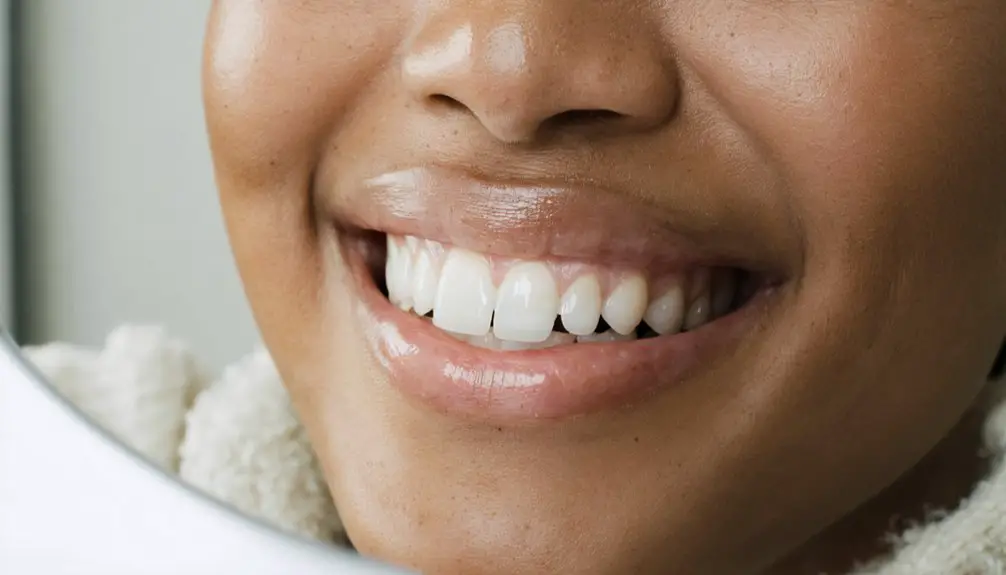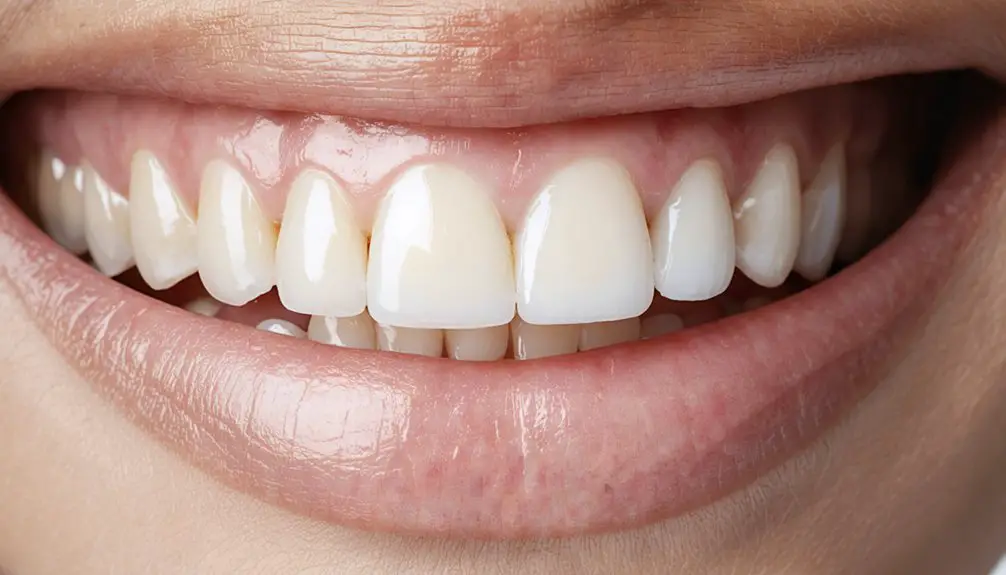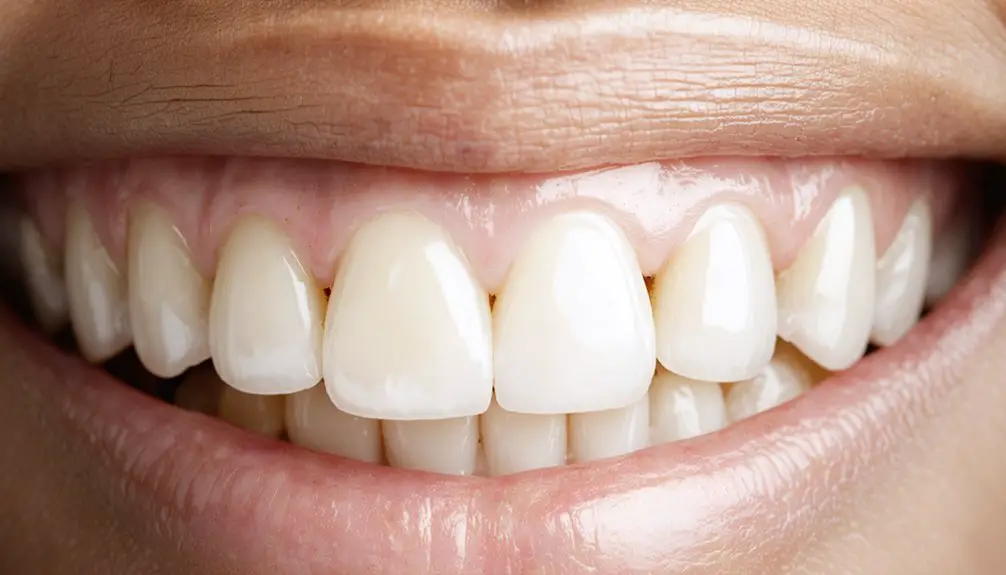Professional teeth whitening can greatly improve your overall oral health by motivating better dental hygiene habits. When you invest in whitening treatments, you’re more likely to maintain thorough brushing and flossing routines to preserve your results. The process also encourages regular dental visits, allowing for early detection of potential issues like decay or gum disease. Understanding the connection between whitening and oral health reveals additional benefits beyond cosmetic improvements.
Key Takeaways
- Teeth whitening treatments motivate patients to maintain better oral hygiene habits through improved brushing, flossing, and regular dental visits.
- Professional whitening consultations enable early detection of dental issues like decay and gum problems during pre-treatment examinations.
- Regular whitening appointments create opportunities for dental professionals to monitor oral health changes and provide timely interventions.
- Maintaining whitening results requires consistent oral care practices, which directly benefits overall dental health and hygiene.
- Professional teeth whitening combines with regular cleanings to create a comprehensive approach to dental care and long-term oral health.
The Science Behind Professional Teeth Whitening
Professional teeth whitening relies on powerful oxidizing agents – primarily hydrogen peroxide and carbamide peroxide – that penetrate deep into tooth structure to break down stain molecules.
The whitening chemistry involves oxygen radicals targeting organic chromophores responsible for discoloration, fragmenting them into smaller, colorless compounds that diffuse out of the tooth surface. The effectiveness and speed of results depend on the active agent concentration used during treatment.
Different peroxide concentrations determine treatment effectiveness, with professional applications using higher strengths than over-the-counter options.
In-office treatments can contain up to 40% hydrogen peroxide for rapid results, while take-home professional trays use carbamide peroxide for extended release whitening.
The process works through your tooth’s porous enamel structure, reaching stains in both the enamel and underlying dentin layers. The whitening treatment can target both extrinsic and intrinsic stains effectively.
Some treatments incorporate light activation to potentially accelerate the oxidation process, though evidence for enhanced results remains mixed.
Long-Term Benefits for Oral Hygiene
While the immediate cosmetic effects of teeth whitening are apparent, the procedure delivers considerable long-term benefits for oral hygiene maintenance.
You’ll find that whitening motivation markedly improves your oral hygiene habits, as visible results encourage you to maintain a cleaner, brighter smile. Studies show that patients who undergo professional whitening demonstrate better plaque control and reduced tartar buildup over time. Professional dental supervision ensures optimal safety and effectiveness during the whitening process. Regular visits promote dental check-up habits that help identify potential issues early.
The psychological impact of a whiter smile creates a positive feedback loop, leading to more consistent brushing and flossing routines.
You’ll notice improved gum health through reduced bacterial irritation, and your enhanced oral care habits will help prevent cavities and periodontal disease.
When you maintain proper hygiene post-whitening, you’ll extend the brightness of your smile while fostering better long-term oral health.
Common Side Effects and Safety Considerations
Although teeth whitening procedures are generally safe, they commonly produce temporary side effects that you should understand before beginning treatment.
Over half of patients experience tooth sensitivity, particularly during early treatment stages, with symptoms typically resolving within two weeks. A review of clinical data shows 91% of dentists use vital tooth bleaching treatments with successful outcomes. Studies indicate that at-home bleaching results in sensitivity for about 50% of patients. You’ll face increased sensitivity risks with higher peroxide concentrations or if you have gum recession.
Gum irritation is another frequent side effect, especially when whitening solutions contact soft tissues due to ill-fitting trays or strips. You may notice burning sensations, redness, or white patches on your gums.
To minimize these issues, choose lower concentration products, follow application instructions precisely, and consider professional supervision. If you experience severe sensitivity or gum irritation, discontinue treatment immediately and consult your dentist.
Comparing Different Whitening Methods
Selecting an effective teeth whitening method requires careful consideration of multiple factors, including desired results, treatment duration, and cost implications.
While natural remedies like activated charcoal and strawberries offer mild whitening effectiveness, they lack consistency and may risk enamel damage.
At-home LED kits and strips provide convenient solutions with moderate results lasting 6-12 months, but they’re best for maintenance rather than dramatic changes.
Professional in-office treatments deliver superior results, whitening up to 8 shades in 90 minutes with effects lasting 1-3 years.
Advanced systems like KöR Whitening combine professional supervision with custom trays and refrigerated gels, making them particularly effective for stubborn stains. The system’s desensitizing agent helps minimize discomfort during treatment.
You’ll find the most reliable outcomes through professional treatments, though they typically require a higher investment than other options.
Whitening strips require daily application time of 20-30 minutes to achieve gradual improvements in tooth color.
Impact on Daily Dental Care Habits
After investing in teeth whitening, you’ll likely find yourself more committed to thorough brushing and flossing to protect your brighter smile.
Your enhanced oral care habits, including regular professional cleanings and proper brushing technique, will help maintain both the aesthetic results and the health of your teeth.
Incorporating peroxide-based bleaching agents into your whitening maintenance routine can help prolong results when used as directed by dental professionals.
The motivation to preserve your whitening results often leads to lasting improvements in daily dental hygiene routines, reducing your risk of decay and gum disease.
Many patients find that surface stains are easier to prevent when following a consistent oral care routine after their whitening treatment.
Improved Brushing After Whitening
While teeth whitening procedures effectively brighten smiles, they also serve as powerful catalysts for improving daily dental care habits. You’ll likely notice heightened awareness of your oral cleanliness after treatment, which naturally leads to more consistent post-whitening habits.
To protect your newly whitened teeth, you’ll need to modify your brushing techniques. Wait 30-60 minutes after whitening before brushing to allow your enamel to re-harden. Use a soft-bristled toothbrush and gentle strokes to manage sensitivity while maintaining cleanliness.
Before whitening treatments, thorough brushing removes plaque and debris, optimizing the treatment’s effectiveness.
Your investment in whitening often translates to long-term improvements in oral care as you’re motivated to maintain results through better brushing habits and increased attention to dental hygiene.
Maintaining Professional Treatment Results
Professional teeth whitening results can last considerably longer with proper maintenance and strategic oral care habits. To protect your investment, you’ll need to follow specific whitening maintenance tips and enamel protection strategies.
Schedule biannual dental cleanings to remove plaque and tartar buildup that cause discoloration. Alternate between dentist-recommended whitening toothpaste and regular fluoride toothpaste to balance brightening effects with enamel protection.
During the critical 48-hour period after treatment, avoid staining substances like coffee, tea, and red wine. You’ll also want to maintain proper hydration and incorporate crunchy fruits and vegetables into your diet to naturally clean teeth and stimulate saliva production.
For ideal results, use professional-grade touch-up treatments as directed by your dentist, rather than relying solely on over-the-counter products.
Long-Term Hygiene Motivation
Beyond enhancing your smile’s appearance, teeth whitening treatments serve as a powerful catalyst for improving long-term oral hygiene habits. Your investment in whitening naturally motivates you to protect the results through consistent dental care routines and lifestyle modifications.
Research shows that whitening commitment correlates with increased brushing frequency, regular flossing, and reduced consumption of staining substances.
You’re more likely to maintain professional dental visits and follow recommended care protocols to preserve your brighter smile. This heightened awareness of oral health often leads to long-term adherence to proper hygiene practices, including the use of specialized products for stain prevention and sensitivity management.
The psychological boost from improved aesthetics reinforces these positive behavioral changes, creating lasting benefits for your overall oral health.
Professional vs. Over-the-Counter Options

While over-the-counter whitening products offer convenience and accessibility, professional treatments provide superior safety through customized application and expert oversight of your oral health.
You’ll experience more dramatic and uniform results with professional whitening due to higher-strength agents and precise delivery systems that effectively target both surface and deep stains.
Your investment in professional treatment typically yields longer-lasting results that can persist for months or years, compared to the temporary effects of OTC products that require frequent reapplication.
Safety Comparison Across Methods
As safety concerns surrounding teeth whitening continue to grow, understanding the key differences between professional and over-the-counter methods becomes essential for making informed treatment decisions.
Professional treatments offer superior whitening safety through controlled chemical exposure, specialized desensitizing agents, and expert monitoring.
- Professional treatments use higher concentrations but shorter exposure times, reducing risks through careful supervision and customized application.
- Over-the-counter products contain lower concentrations but lack professional oversight, potentially leading to misuse and prolonged chemical exposure.
- Professional methods include pre-screening for risk factors and contraindications, while DIY options don’t account for individual oral health conditions.
If you’re considering teeth whitening, professional supervision greatly minimizes risks of sensitivity, gum irritation, and enamel damage while maximizing treatment effectiveness.
Whitening Effectiveness Analysis
Despite common assumptions about professional treatments being superior, research reveals that both professional and over-the-counter whitening methods can achieve comparable long-term results through different approaches.
Recent whitening technology advancements show that lower-concentration products used over extended periods can match the effectiveness of high-concentration professional treatments.
Treatment duration effects play an essential role in outcomes. While professional treatments with 35-40% hydrogen peroxide deliver faster initial results, at-home options with 10-16% carbamide peroxide achieve similar whitening levels over time.
You’ll find that professional treatments can lighten teeth up to 10 shades quickly, but OTC products containing ~3% hydrogen peroxide can provide meaningful improvements with consistent use over weeks or months.
The key difference lies in speed rather than ultimate effectiveness.
Long-Term Results Differences
When comparing long-term outcomes between professional and over-the-counter teeth whitening options, several critical differences emerge regarding sensitivity, enamel integrity, and gum health.
Professional treatments offer superior whitening longevity, lasting up to 2-3 years with proper maintenance, while OTC products typically show results for only a few months.
- Professional treatments provide controlled application with protective measures, minimizing risks of prolonged sensitivity and enamel damage.
- OTC products can lead to cumulative enamel wear and increased sensitivity due to frequent reapplication and imprecise use.
- Gum irritation risks are considerably lower with professional treatments due to precise application and customized protective barriers.
These long-term outcomes demonstrate that professional whitening delivers more sustainable results while better preserving your oral health, though both methods require moderation to maintain enamel integrity.
Psychological Effects on Dental Health Maintenance

The psychological impact of dental health extends far beyond physical discomfort, creating a complex interplay between mental wellbeing and oral care maintenance.
Oral health and mental wellness are deeply interconnected, with each significantly influencing the other in an ongoing psychological dance.
If you’re struggling with dental issues, you’ll likely experience decreased self-esteem and social confidence, which can lead to a cycle of neglecting oral hygiene.
Your mental state greatly influences how you maintain your dental health. When you’re experiencing depression or anxiety, you’re less likely to brush regularly, floss, or schedule dental visits.
This neglect often results in worsening oral conditions, which further impacts your psychological wellbeing. Understanding this connection is essential, as addressing dental concerns through treatments like teeth whitening can provide a self-esteem boost and improve social confidence, potentially breaking the negative cycle between poor oral health and mental distress.
Managing Risks During Whitening Treatment
Although teeth whitening treatments offer cosmetic benefits, they require careful management of potential risks to guarantee both safety and ideal results. For effective sensitivity management, you’ll want to use desensitizing toothpaste and fluoride rinses while having over-the-counter pain relievers available if needed.
Proper gum protection involves using custom-fitted trays and following application instructions precisely.
Key practices for safe whitening include:
- Avoid overexposure by limiting treatment frequency and duration
- Protect soft tissues by preventing contact with bleaching agents
- Monitor for signs of enamel damage or persistent sensitivity
If you experience prolonged discomfort or notice uneven results, consult your dental professional immediately.
Post-treatment, avoid very hot, cold, or acidic foods to minimize sensitivity and maintain best results.
Whitening’s Role in Preventive Dental Care
Modern teeth whitening serves as a powerful catalyst for improved preventive dental care, motivating patients to maintain consistent oral hygiene routines and regular dental visits.
When you undergo whitening techniques, you’ll likely develop heightened awareness of your oral health, leading to better brushing and flossing habits.
Your whitening consultations provide dentists opportunities to detect early signs of decay, gum issues, or structural problems.
These preventive strategies guarantee safe treatment while monitoring your overall oral health.
You’ll find that combining whitening with regular cleanings creates a thorough approach to dental care, as the desire to maintain your bright smile reinforces positive habits.
Additionally, professional whitening appointments serve as regular check-ins, supporting timely interventions and long-term oral health preservation.
Frequently Asked Questions
Can Teeth Whitening Help Remove Deeply Embedded Tobacco or Wine Stains?
Struggling with discolored teeth? You’ll find professional teeth whitening effectiveness is high for deep tobacco and wine stains, as peroxide-based stain removal techniques penetrate enamel to break down embedded pigment molecules.
How Long Should I Wait After Dental Work Before Getting Teeth Whitening?
You’ll need to wait 7-14 days after fillings and at least two weeks after other dental work to avoid dental sensitivity. Consult your dentist for a personalized waiting period based on your procedures.
Does Whitening Affect the Color of Dental Crowns or Veneers?
No, whitening won’t change your crown discoloration or veneers since they’re made of non-porous materials. These restorations maintain their original color, so veneer maintenance through replacement may be needed for color matching.
Can Teenagers Safely Undergo Professional Teeth Whitening Treatments?
You can safely whiten your teen’s teeth under professional supervision after age 14, once permanent teeth have erupted. A dentist will guarantee proper concentrations and monitor treatment to prevent sensitivity issues.
Will Whitening Treatments Make Existing Cavities or Dental Problems Worse?
75% of untreated cavities worsen with whitening. You’ll experience increased dental sensitivity issues and risk permanent damage. For ideal whitening safety concerns, have your dentist treat cavities before attempting any bleaching procedures.
References
- https://pmc.ncbi.nlm.nih.gov/articles/PMC8352057/
- https://ec.europa.eu/health/scientific_committees/opinions_layman/en/tooth-whiteners/l-3/5-tooth-whitening-products.htm
- https://www.todaysrdh.com/what-the-research-shows-regarding-the-efficacy-of-dental-whitening-options/
- https://pmc.ncbi.nlm.nih.gov/articles/PMC4058574/
- https://www.frontiersin.org/journals/dental-medicine/articles/10.3389/fdmed.2021.687507/full
- https://progrin.com/blog/the-science-and-art-of-professional-teeth-whitening/
- https://heartofthecitydental.com/how-teeth-whitening-works/
- https://www.champaigndentalgroup.org/about-us/blog-articles/how-teeth-whitening-works-the-science-behind-brighter-smiles
- https://www.clinicalresearchdental.com/blogs/whitening-hygiene/the-science-behind-teeth-whitening
- https://www.hmfamilydentistry.com/blog/5-surprising-benefits-of-teeth-whitening-beyond-aesthetics/



